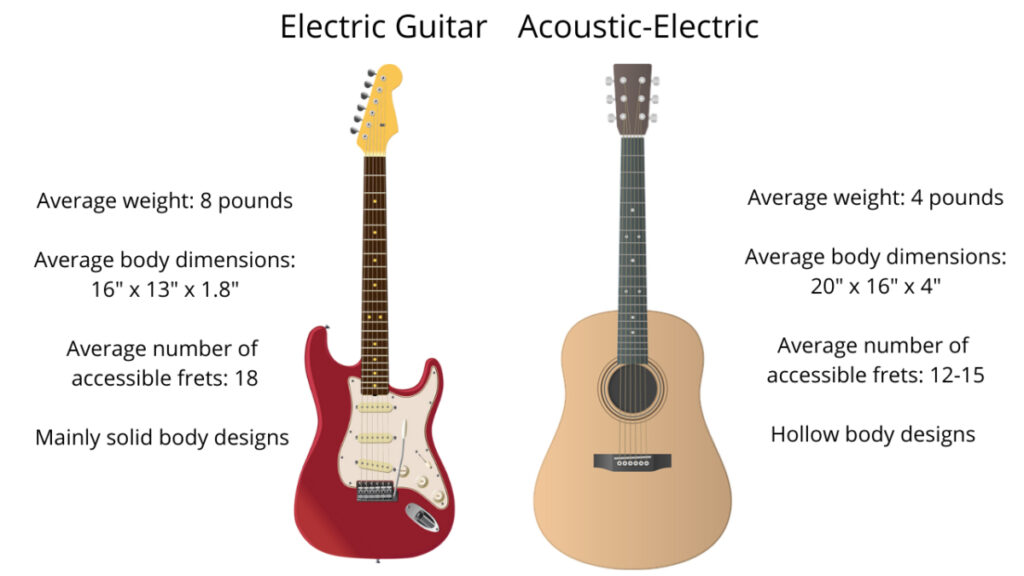If you’re looking to upgrade your guitar, or are a complete beginner choosing your very first guitar, then you you’ll be wondering which is best for you, a standard electric guitar or an electro-acoustic guitar. These are two pretty different instruments, so in this article, I’ll compare the look, sound, feel and price of each, as well as the pros and cons to help you make your decision.
Electric vs Acoustic-Electric Guitars
Acoustic-electric guitars can be played unplugged, whereas electric guitars need to be plugged into an amp to be heard properly. Acoustic-electric guitars have a larger body, but are lighter than electric guitars. Both types of guitar are suitable for beginners.
In order to fully understand the differences between these two instruments, let’s take a look at the sound, look and feel of them compared against each other.
Sound
Really the most important thing to consider when looking at electric and electro-acoustic guitars, is how they sound. Here are some main points:
- Electric guitars will sound good when plugged into an amplifier. This allows you to achieve a variety of tones including clean, gritty, and distorted. When unplugged, the guitar will be very quiet, and the tone is very thin and weak, and not really suitable for anything more than practicing technique.
- Acoustic-electric guitars sound good when plugged into an amplifier, and when unplugged. They have a louder, warmer and fuller clean tone, however can not be distorted.
Acoustic and electro-acoustic guitars are very similar, and have a unique tone which is very distinct from the electric guitar’s sound. Here’s a really great video by one of my favourite YouTube guitarists where they perform solos on an acoustic and electric guitar back to back where you can hear the differences really well.
Volume
Acoustic-electric guitars are louder when unplugged, compared to electric guitars. When plugged in, acoustic-electric guitars and electric guitars are capable of reaching the same volume.
This means electric guitars are often better for people with neighbours who live in thin-walled houses/ flats, because you can plug in headphones and play without anyone else really being able to hear if they’re not in the room.
If you’re concerned about volume then make sure you check out my tips for practicing electric and acoustic guitars quietly.
Tone
The tone on an electric guitar is more customisable than an acoustic-electric guitar. The amplifiers and the controls on the guitar itself allow you to adjust the level of distortion and add effects such as tremolo easily.
Acoustic-electric guitar tones are more limited because the sound is more due to the tone woods used, so it is less versatile and you’re pretty much stuck with what you have.
Acoustic-electric amps do have some features that allow you to add reverb effects, and adjust how bright or dark the tone is, but they are much more limiting.
Music Styles
Due to the level of versatility an electric guitar has, it can be used for a variety of music styles ranging from country to heavy metal. Acoustic-electric guitars are best suited to pop and some soft rock songs, as they cannot be distorted like electric guitars can.
Sensitivity
Acoustic-electric guitars tend to be less sensitive than electric guitars when it comes to amplifying unwanted sounds such as strings sliding and your palm hitting the strings. This often allows even lesser-skilled players to sound more professional and polished on an acoustic-electric, compared to an electric guitar.
Shape and Look
The shape and overall look of electric-acoustic guitars, and acoustic guitars are very different. This affects both the sound, and the feel of the instruments.
Generally, there is more variation in the shape, colours and finish on electric guitars, compared to acoustic-electric models. Here are the main differences between the two guitar types:
Dimensions
- Acoustic-electric guitars usually weigh between 2.5 lbs and 5 lbs (between 1.1 kg and 2.2 kg). Electric guitars usually a lot heavier and weigh between 6 and 12 pounds (2.7 – 5.5 kg).
- Electric guitars have smaller bodies than electric-acoustic guitars. The average dimensions of an acoustic-electric guitar body are 20″ x 16″ x 4″ or 60cm x 41cm x 10 cm (length x widest point x depth). The average dimensions of an electric guitar body are 16″ x 13″ x 1.8″ or 40.5cm x 33cm x 4.5 cm.
- The average number of accessible frets on an acoustic-electric guitar is 12-15, and the average number on an electric guitar is around 18.
- The average scale length of an acoustic-electric guitar and electric guitar is 25 inches (63.5 cm).
Style
- All electric-acoustic guitars have a hollow body. Most electric guitars have a solid body, but some have hollow and semi-hollow designs.
- There are 5 main acoustic-electric guitar body shapes: dreadnought, parlour, jumbo, auditorium and classical.
- There are 6 main electric guitar body shapes: S-style (Stratocaster), T-style (Telecaster), LP-style (Les Paul), SG-style, Offset and Flying V.
- Electric guitars will have 3 main controls on the body: pickup selector, tone control and volume control. Acoustic-electric guitars generally do not have controls on the front of the body.



Feel
The way a guitar feels to play is a really important factor to consider, particularly for beginners as the more comfortable the instrument feels to play, the easier you will find it to learn. Here are the main things to consider when comparing electric-acoustic and acoustic guitars:
- Electric guitars are on average 1.5-2 times heavier than electric-acoustic guitars which may cause you to fatigue faster particularly when stood up.
- Electro-acoustic guitars have larger bodies (around 2x wider) than standard electric guitars, meaning smaller players often find electric guitars easier to handle.
- The “action” (height the strings are from the fretboard) is lower on electric guitars compared to acoustic-electrics, meaning that it is easier to fret notes on an electric guitar as it requires less finger strength.
- Electric guitars have thinner strings than acoustic-electric guitars which often feel more comfortable for beginners.
The best thing to do, is to go to your local guitar store and try each type of guitar out, both sitting and standing. Even if you’re a total beginner, make sure you hold both types of guitar as it will give you a feel for which you find more comfortable.
Try a few different styles of each guitar type, and hold the guitar at different places for a few minutes to test them out. Even if you don’t play any notes, it’ll definitely be helpful to try it.
As long as you pick a guitar that is suitable for your frame, whether it’s an acoustic-electric or a standard electric guitar, you will get used to the feel of it after a while. So don’t worry too much if they both feel a bit awkward at first!
Price
Entry-level acoustic-electric and electric guitars usually cost around $150 for a good quality instrument. Amplifiers for acoustic guitars, and electric guitars also cost roughly the same amount, starting at $75 for a good model.
Check out my articles on the average price of acoustic guitars, and the average price of electric guitars to see over 30 guitars and their features compared.
Pros and Cons
Here is a quick summary table to take you through the pros and cons of electric guitars vs acoustic-electric guitars.
| Electric Guitar | Acoustic-Electric Guitar |
| Quiet when unplugged | Loud when unplugged |
| Suits a range of music styles | Suits a limited range of music styles |
| Suitable for clean and distorted tones | Suited for clean, undistorted tones |
| Heavier (average 8 pounds) | Lighter (average 4 pounds) |
| Smaller body | Larger body |
| Low action and thin strings | High action and thick strings |
| Needs an amp to be played properly | Can be played without an amp |
Which Should You Choose?
As I mentioned earlier, acoustic-electric guitars are very different instruments, and your choice will often come down to the styles of music you want to play. If you’re a complete beginner and prefer acoustic-style songs, then of course an electric-acoustic would be the best fit. If you want to play a variety of music styles and use distortion, then you’ll need an electric guitar instead.
In terms of which is best for beginners, there isn’t a whole lot of difference when considering how easy the guitars are to play. Whichever you start with, you’ll be able to learn just fine. I personally started with an electric guitar, as I wanted to use distortion and play rock songs instead of acoustic-style music, and this was the only factor that affected my decision.
If you’re really torn, I’d say go with an electric guitar, because at a push, you can use the amp settings and controls to sound as close to an acoustic as possible. Whereas it’s much harder to make an acoustic guitar sound like an electric. I’ve written guides on both methods here:
- How to Make an Electric Guitar Sound Like an Acoustic
- How to Make an Acoustic Guitar Sound Like an Electric
Here are some more articles you might find helpful:
